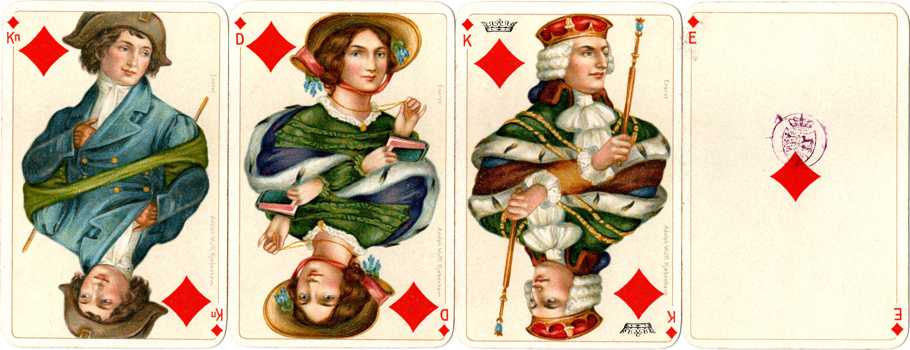
These are by Adolph Wulff of Copenhagen, a name I haven't come across before. I usually buy old playing cards for one of two reasons: they're old and British; they're old and pretty. I bought these because they were old and I thought they were pretty.
Given that they are pretty, though, how come I haven't seen more playing cards published by Wolff? Any company that could print cards looking like this ought to have done well. Ah, well it turns out that Wolff didn't print the cards, they just designed them; the cards were printed by Dondorff, the German company that's my favourite manufacturer of playing cards. That's why they look so gorgeous.
[Aside: the moment I typed that word, my wife commented on the weather saying "It looks gorgeous out there". There's definitely something fishy going on with this universe right now.]
The cards definitely are by Dondorff, too, because the Jack of Clubs has the Wolff logo on it; Dondorff always put the company logo on the Jack of Clubs. Also, the flimsy packet they come in has the same flimsy tab on it that Dondorff's flimsy packets do.
As for how old these care are, well therein lies a problem. The packet says that this is an "Elite No. 80 m/Guldhj (Eneret)" deck, which according to the World Web Playing Cards Museum (a site I trust) it is indeed. The "Eneret" means that Wulff had exclusive rights to the images; the Guldhj refers to the fact that the corners of the cards are edged in gold leaf. The WWPCM calls the cards "Luxusspiel" rather than "Elite", but that's probably because this is what Dondorff called them in their catalogue.
The deck is supposed to include a Joker, but there isn't one. OK, well some people collect Jokers and will happily take them while leaving the rest of the deck incomplete. I disapprove of this, but it happens. On the other hand, it perhaps never had a Joker in the first place, because there are variations in packs that aren't always known to the WWPCM. This isn't therefore the problem I have here.
The problem is that the WWPCM dates these cards 1920-1933 (Dondorff having closed in 1933). That's fair enough, but if you look at the Ace of Diamonds, you'll see there's a tax stamp on it. According to the Tax Stamps web site I use (which I also trust), this stamp was only used from 1890 to 1918, whereupon the colour changed to green. Sometimes, a tax office might take a year or so to switch over to a new stamp, but not a new colour, and not two years.
So, 1918 doesn't intersect with 1920-1933, which is where the problem lies. Denmark was neutral in World War I, so could trade with Germany; the cards could indeed have been imported in 1920. The tax stamp is at least two years earlier, though.
I'll go with 1918, I think. The absence of a Joker could indicate the cards predated the ones catalogued as "Luxusspiel", and although I have come across cards bearing tax stamps several years after their supposed end of use, that usually only happens when they're stamped in the country of manufacture; Denmark stamped its cards on import. War or civil unrest could be a factor, but Denmark wasn't at war during this period. 1918 seems about right.
They're still a pretty set of cards, though, however old they are.